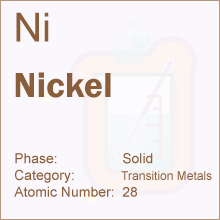 Periodic Table -> Nickel
Periodic Table -> NickelNickel
Nickel DetailsNickel Symbol: Ni
Nickel Atomic Number: 28
Nickel Atomic Weight: 58.693
What is Nickel?
Nickel (atomic number 28, symbol Ni) is a lustrous metal with a silvery-white color and slight golden tinge. The element is ductile and hard and belongs to the group of transition metals. Nickel is one of the 4 chemical elements with magnetic properties near or at room temperature. The others are gadolinium, cobalt, and iron.
Axel Fredrik Cronstedt was the first to isolate and classify nickel in 1751. Today, major production sites include Norilsk in Russia, New Caledonia, and Sudbury region in Canada. The most important ore minerals of nickel are pentlandite, garnierite, and limonite. The bulk of nickel is mined from laterites and magmatic sulfide deposits, with major ore minerals being pentlandite and nickeliferous limonite.
Around room temperature, the element is ferromagnetic, and nickel-based magnets are of intermediate strength between rare-earth magnets and iron-based magnets. Nickel is valuable for the alloys it forms, including new superalloys and nickel-steels. This element has a number of commercial applications – 9 percent of the global nickel production is used to make Iconel, nickel clad, malleable nickel, and other superalloys; 6 percent is used in plating, 3 percent in electronic and heat resistance alloys, 3 percent for nickel cast irons, and 2 percent for nickel bronzes and brasses. The element is also used in a variety of recognizable and specific consumer and commercial products such as coinage, stainless steel, electric guitar strings, and rechargeable batteries. Nickel is also used in the production of alnico magnets and microphone capsules. It is mainly an alloy metal, which is added to nickel cast irons and nickel steels, of which there are many varieties. Nickel is widely used in other alloys, including bronzes and brasses, and alloys with cobalt, lead, aluminum, and copper. Because it resists corrosion, the element is used in rocket engines and gas turbines. Nickel mesh or nickel foam is used in the production of gas diffusion electrodes while nickel alloys have application as catalysts for different hydrogenation reactions.

Most nickel is found in the earth’s iron-nickel core, which makes it inaccessible. Organic matter absorbs it, and this is why oil and coal contain considerable amounts. Nickel is also an important component of some enzymes in beans. The element occurs combined with sulphur and arsenic in nickel glance, with arsenic in niccolite, and with sulphur in millerite. The metal is mined in South Africa, Canada, Cuba, Nova Caledonia, Australia, and Russia.
Nickel does not bio magnify up the food chain, and it is not known to accumulate in animal and plant species. Some microorganisms may experience growth decline, but they tend to develop resistance with time.
Food contains small amounts of nickel, but fats and chocolate have high quantities. Nickel uptake also increases when people consume vegetables from heavily polluted soils. The element is also found in some detergents. Humans are exposed to nickel by smoking cigarettes, eating food, drinking water, and breathing. It is beneficial in small quantities but can be a health hazard if the uptake is high. Side effects include respiratory failure, lung embolism, heart disorders, and skin rashes and other allergic reactions. Dizziness and sickness have been reported after exposure to nickel gas. Exposure can lead to the development of nose cancer, lung cancer, prostate cancer, and larynx cancer. Once acquired, nickel sensitivity persists indefinitely.
You can
link to this page, using the code below:
Periodic Table |
Banks
© ElementsDatabase.com 2015 | Privacy | About | Contact